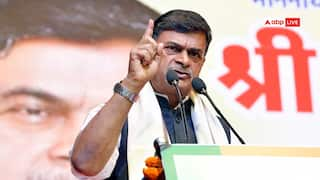(Source: ECI | ABP NEWS)
Rise In Services Demand Helps India's Economy Steady Amid High Inflation
The indicators showed sentiment in the services sector, which accounts for over 50% of the $3.2-trillion economy, was upbeat, tax revenue were robust and demand for loans high, Bloomberg reported

India’s economy showed signs of stabilising last month, with strong demand for services helping weather headwinds from high inflation, as reported by Bloomberg.
From August, Bloomberg has changed three of the eight indicators it uses to track the economy’s so-called animal spirits. It now includes power demand, goods and services tax collection, and unemployment rate, in place of the Citi India Financial Conditions Index, factory and infrastructure output.
The indicators showed sentiment in the services sector, which accounts for over 50 per cent of the $3.2 trillion economy, was upbeat, tax revenue were robust and demand for loans high. A rising jobless rate was the main drag during the month. Still, the needle on a dial measuring overall activity was unchanged from July, as the gauge uses a three-month weighted average to smooth out volatility in the single month readings.
ALSO READ | Wholesale Inflation Eases To 12.41 Per Cent In August On Softening In Prices Of Manufactured Goods
According to the Bloomberg report, the steady pace of activity is expected to give monetary policy makers the confidence to continue raising interest rates to fight above-target inflation when they meet later this month. The Reserve Bank of India, which has raised interest rates by a total of 140 basis points in three moves this year, has said it targets a soft landing for the economy where growth isn’t sacrificed too much.
Purchasing managers’ surveys showed a rebound in S&P Global India Composite PMI in August, thanks largely to a stronger expansion in services activity amid an upturn in new orders and slower increase in input costs.
Trade deficit hovered close to a record high last month as exports growth was little changed from a year ago, while imports jumped nearly 37 per cent, according to preliminary data from the commerce ministry. A 2.2 per cent year-on-year dip in value of non-petroleum exports in August weighed on the overall performance.
Bank credit demand jumped 15.5 per cent, the most since November 2013, despite rising interest rates, data from the central bank showed, while liquidity in the banking system continued to be in surplus. That helped broadly support consumption activity, underscored by a jump in monthly goods and services tax collection. GST revenue in August came in at Rs 1.44 lakh crore ($18 billion), compared to early days of the pandemic when collections fell to as low as Rs 32,300 crore.
Electricity consumption, a widely used proxy to gauge demand in industrial and manufacturing sectors, showed activity is picking up. Numbers from India’s power ministry showed peak demand met in August jumped to 185 gigawatt from 167 gigawatt a month ago. However, rising unemployment numbers tempered the overall optimism, with data from the Centre for Monitoring Indian Economy Pvt. showing the jobless rate climbed to 8.3 per cent, the highest level in a year. That shows the current pace of expansion isn’t enough to create jobs for the million plus people joining the workforce every month.







































